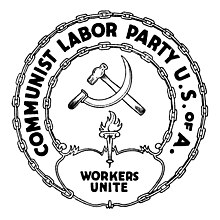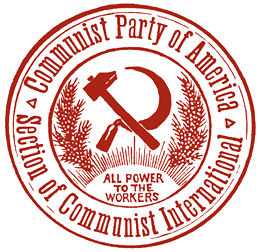 | |
| Anglo members of the Socialist Party Left Wing and dissident state parties found the CLP on August 31, 1919 |
On August 31, 1919 at a rump meeting in Chicago of
Left Wing members of the fractured Socialist Party, the Communist Labor Party (CLP), a predecessor to the Communist
Party USA (CPUSA), was founded. The year was one of great turmoil. Long time
Socialist Party leader and presidential candidate Eugene V. Debs was in the Federal prison at Atlanta for giving a speech
opposing World War I. Many socialists and unionists were aflame with passion for the apparently successful Russian Revolution. Attorney
General A. Mitchell Palmer with the enthusiastic
assistance of the young leader of the Bureau
of Investigation, J. Edgar Hoover,
had launched his raids against aliens and radicals. An unheard of era of government repression was
sweeping the land.
Earlier in the year the
SP’s well established network
of language
federations, each of which had its own publications
and leadership, in cooperation with Left Wing state parties had captured a majority on the Party’s National Executive Committee (NEC).
Alarmed, the regulars of the
outgoing NEC declared the election
invalid charging the language federations with irregularities. They expelled
the leaders of several federations and suspended recognition of the Russian, Lithuanian, Polish, Lettish (Latvian), South Slavic,
and Ukrainian federations and the
entire state parties of Michigan, Massachusetts, and Ohio. The New York State
Executive Committee suspended and reorganized
Left Wing locals and branches representing nearly half the
state's membership. Needless to say,
such high handed tactics led to an uproar in the Party.
| Journalist Jack Reed was a key figure in the the founding of the Communist Labor Party. |
The language federations
joined by the Michigan state party responded with a call to a founding
convention of the Communist Party of
America (CPA) to be held in Chicago on September 1. Many leading English speaking left wingers,
including NEC members Alfred Wagenknecht
and L.E. Katterfeld and the dashing
journalist John “Jack” Reed, lionized by the Party rank and file for his eye witness account of the Russian October Revolution in Ten
Days That Shook the World, decided to stay in the SP and try to win control back from the
regulars. The Party called an Emergency National Convention in
Chicago scheduled for Aug. 30. But the
regulars controlled the majority of State parties, suspended parties and
federations were banned, and a credentials
committee ruled against seating many other Left Wing delegates.
John Reed and Benjamin Gitlow planned to crash the
convention anyway, but officials were tipped
off and called the police, who
obligingly expelled the leftists from the hall.
The remaining leftist delegates walked out. Meeting in a rented room directly below the official convention the expelled
delegates formed the Communist Labor
Party with Wagenknecht at its head.
 |
| ....A day later on September 1st Foreign Lannguage section of the Socialist Party founded another Communist Partmey. Both claimed membership and support of Moscow and the Comintern. |
Meanwhile the founding
convention of the Communist Party of
America went ahead as planned the next day.
Suddenly there were two competing Communist Parties, both claiming allegiance to the Russian Revolution
and to the Communist International (Comintern), a situation that displeased V. I.
Lenin.
Both infant parties were
soon victims of the expanding Palmer
Raids and leaders of both were arrested
or in hiding. Both were forced to essentially go underground by December.
In January 1920 the
Comintern ordered the two parties to merge as the United Communist Party, and to follow the party line established in Moscow. .A faction of the CPA held out for a while
but was forced into line by 1921. Many English language leftists, however, soon
left the Party and it is estimated that less than 5% of the membership were
native English speakers. Through the
decade the Party was beset with internal
dissent and was frequently reined in by the Comintern.
Although the Communists
were allowed to resume operations as a legal organization, the experience in
the underground and the formation of cells
and the like as well as stringent control from Moscow were stamped on the
Party. The Red Scare of 1919-1920 prevented the Communists from ever becoming
a mass or popular party and helped create the secretive culture and fealty to the Soviets that made it the nightmare
of post-World War II of conservatives.
j |
| Former IWW organizer William Z. Foster spent most of the '20's marginalized in the United Communist Party, the forced merger of the CLP and CPA. But the Comintern put him at the head of re-incarnated Communist Party of the United States (CPUSA) and endorsed his bore from within strategy of working inside the conservative business unions of the AFL instead of joining the IWW or organizing explicitly Marxist labor unions. |
Initially many rank and file members of the Industrial Workers of the World (IWW) were enthusiastic for the new
party and some leaders, like William Z.
Foster jumped to the new organization.
But the defection of William D. “Big Bill” Haywood to Moscow after the conviction of 101 IWW
leaders for sedition in 1919
left a bitter taste in many mouths. When
reports by Emma Goldman and others
exiled to Russia exposed the authoritarian
underside of the Lenin regime, support dwindled further. The Party began to demand that the IWW submit itself to Party leadership—a
demand that was rudely rejected by
the union. When party members meddled
in important IWW strikes of the
‘20’s the rift became pronounced. By the
end of the decade the IWW was firmly anti-Communist.
In 1929 the Party was
renamed the CPUSA. Foster, after being
frozen out at the demand of Kremlin leaders through most of the ‘20’s emerged
as the new Party leader and instituted the directed policy of boring from within the conservative labor movement and
shunning the independent IWW. CP militants helped form and establish the Congress of Industrial Organization in heavy industry during the ‘30’s.
Many well-meaning idealists entered the Party in the Depression years and did heroic work in the labor movement and
elsewhere. But the fickle dictates of Moscow took a toll. A joke around IWW circles years later was
that you could tell just how naïve a
leftist was by when they finally got disgusted and abandoned the CP—the 1936-38
Stalinist Purge Trials in Russia, the Hitler/Stalin Pact, the roughshod imposition of Soviet style government over Eastern Europe in the post war years,
or the final straw for many, the suppression of the Hungarian Uprising in 1956.
When the next great upsurge of the left occurred
during the Civil Rights movement and
Vietnam War, the CPUSA found itself
mainly on the sidelines, distrusted
by the New Left and ignored as
irrelevant. Self-proclaimed Marxist-Leninists split among a bewildering profusion of new parties and organizations.
With the fall of Communism in the Soviet Union
the CPUSA was left a virtual orphan. It numbers continue to dwindle to a hard core of aging militants,
many of them from the decedents from those old ethnic federations and from the needle trades in New York.



